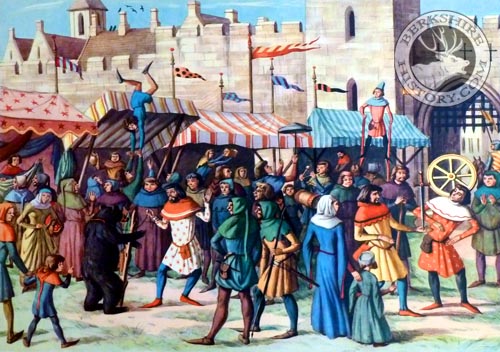 |
 |
|||
|
 The Great The GreatReading Fairs Trade & Revelry in the Middle Ages & Beyond Every year, four fairs were held in Reading. Candlemas Fair (2nd February), May Fair (1st May) and St. James' Fair (25th July) were chiefly cattle fairs. From all parts of the country droves of horses and oxen arrived at Reading, and dealers carried on brisk business. So numerous were the cattle that, in 1840, it was found necessary to hold St. James's Fair, not in Friar Street and Broad Street as hitherto, but in the Forbury. The fourth fair was the Michaelmas Cheese Fair (25th September). This fair was originally for the sale of hops and serges as well as of cheese and, formerly, it used to be held in the old Cheese Row. As early as 1697, however, it was necessary to move it to the Forbury. Between 1750 and 1850, owing to the improved roads and waterways, and owing to the central position of Reading, the fair became one of the principal cheese fairs in the country. From the dairy farms of Gloucestershire, Somerset, Wiltshire and Dorset, as well as Berkshire, hundreds of waggons and barges brought cheese to Reading. The carters often took back with them loads of birch brooms, which they sold in the towns and villages as they went home. The Cheese Fair seems to have reached its highest note about the end of the 18th century. In 1795, it was recorded that 1,200 tons of cheese were offered for sale in the Forbury. This amount of cheese would be worth £60,000. During the next fifty years, the amount of cheese brought to the fair each year varied from 500 to 1,000 tons. The opening of railways seems to have caused the amount of cheese shown in the Forbury to diminish, for the custom arose of leaving it unloaded in the trucks, and of selling it by sample. Michaelmas Fair brought together a multitude of people. It was a fair at which servants were hired. Hundreds of farm servants, both men and women - shepherds, waggoners, dairymaids, milkmen, ploughmen, woodmen and others - came to the fair to seek employment, or a change of masters. They stood in long lines while the farmers went up and down, picking and choosing amongst them. Cattle from Scotland, ponies from the Shetland Islands, from the New Forest or from Wales, were also to be seen, and there were dealers, cheap-jacks and showmen of all kinds. The Forbury was crowded, not only with stands of cheese, but with stalls, booths, swings, roundabouts, peep-shows, wild beasts in cages and other wonders. For many years the fair used to be visited by Wombwell's Menagerie. Pickpockets and sharpers of all kinds mingled with the crowd, and usually reaped a good harvest. Edited from W.M. Childs' "The Story of the Town of Reading" (1905)
|
|||
| © Nash Ford Publishing 2017. All Rights Reserved. | ||||





